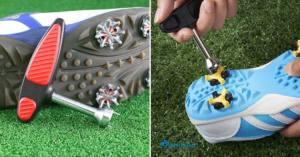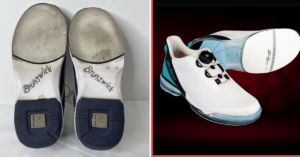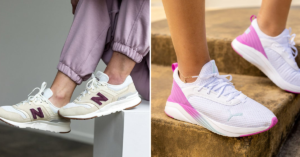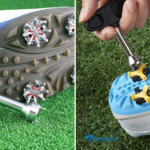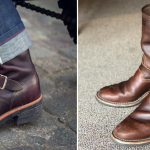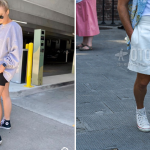Running shoes are an essential part of any runner’s gear. However, they tend to wear out quickly, posing a significant challenge for eco-conscious runners and fitness enthusiasts. Disposing of old running shoes in a sustainable manner is crucial to reducing waste and minimizing environmental impact. In this blog post, we’ll provide a comprehensive guide on how to recycle running shoes effectively. This guide will include identifying when it’s time to recycle your shoes, exploring recycling programs, and even creative repurposing ideas.
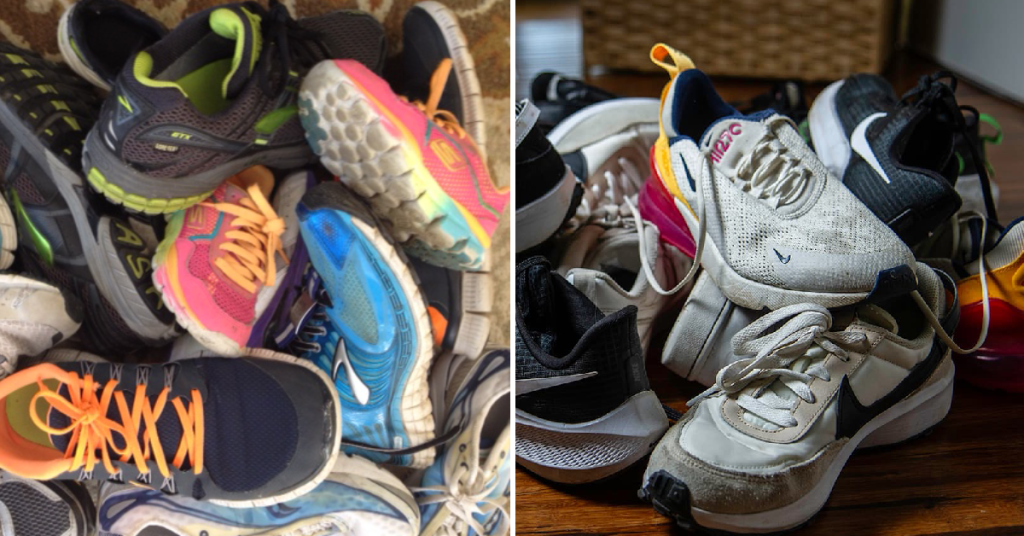
The Importance of Recycling Running Shoes
Every year, millions of pairs of running shoes end up in landfills. These shoes are made from synthetic materials that can take hundreds of years to decompose. Recycling old running shoes helps reduce waste, conserve resources, and limit pollution. By choosing to recycle, runners can contribute to an eco-friendly lifestyle and promote sustainability in the fitness community.
Additionally, recycling running shoes can help provide footwear to those in need. Many recycling programs donate gently used shoes to underprivileged people, offering comfort and support. Participating in these initiatives not only helps the environment but also makes a positive social impact.
Recycling running shoes also encourages manufacturers to adopt more sustainable practices. When consumers demand eco-friendly disposal options, brands are more likely to invest in research and development for greener materials and processes. This shift can lead to reduced carbon footprints and a healthier planet overall.
Identifying When It’s Time to Recycle Your Running Shoes
Knowing when to retire your running shoes is essential for both performance and safety. Most running experts recommend replacing shoes every 300-500 miles. However, several factors can influence this range, including your running style, weight, and the type of terrain you run on.
One telltale sign that it’s time to recycle your running shoes is visible wear and tear. Look for worn-out soles, holes, or frayed fabric. These signs indicate that the shoes have lost their cushioning and support, which can lead to injuries.
Another indicator is discomfort during runs. If you experience pain or discomfort in your feet, legs, or lower back, it may be time to replace your shoes. Worn-out shoes can cause improper alignment and stress on your joints, increasing the risk of injury.
Lastly, pay attention to the shoe’s midsole. Over time, the cushioning material breaks down and loses its shock-absorbing properties. If your shoes feel less responsive or springy, it’s a sign that the midsole is no longer providing adequate support.
Researching Local Shoe Recycling Programs
Before recycling your running shoes, it’s essential to research local recycling programs. Many communities have initiatives specifically for shoe recycling. Start by checking with your local waste management facility or recycling center. They may have information on drop-off locations or special collection events.
Another option is to contact local running stores. Many stores partner with shoe recycling programs and offer collection bins for old shoes. These programs often work with non-profit organizations to ensure that donated shoes are either recycled or given to those in need.
You can also explore online resources. Websites like Earth911 and Recycle Nation provide searchable databases of recycling programs by location. Simply enter your zip code to find nearby options for recycling running shoes.
Step-by-Step Guide to Recycling Running Shoes
- Clean Your Shoes: Before recycling, clean your shoes thoroughly. Remove any dirt, debris, or mud. This step is crucial, especially if you’re donating the shoes, as cleanliness ensures they are in good condition for the next user.
- Remove Insoles and Laces: Take out the insoles and laces from your running shoes. These components are often made from different materials and may need to be recycled separately. Some programs accept them, while others do not.
- Sort Shoes by Condition: Assess the condition of your shoes. If they are still in good shape, consider donating them. If they are beyond repair, proceed with recycling. Sorting helps streamline the process and ensures shoes are disposed of appropriately.
- Locate a Recycling Program: Use online resources or contact local facilities to find a suitable shoe recycling program. Ensure the program accepts running shoes and follows eco-friendly practices.
- Drop Off or Mail Shoes: Follow the recycling program’s instructions for dropping off or mailing your shoes. Some programs offer prepaid shipping labels, making the process convenient and straightforward.
- Spread the Word: Share your recycling efforts with friends and family. Encourage them to recycle their running shoes and participate in sustainable practices. Raising awareness can amplify the positive impact on the environment.
Donating Shoes in Good Condition
If your running shoes are still in good condition, consider donating them instead of recycling. Many organizations accept gently used shoes and distribute them to those in need. Donating your shoes extends their life and provides comfort to individuals who may not have access to quality footwear.
Several non-profits and charities accept shoe donations. Organizations like Soles4Souls, One World Running, and Nike’s Reuse-A-Shoe program collect used shoes and ensure they reach deserving recipients. Check their websites for donation guidelines and drop-off locations.
Local shelters and community centers may also accept shoe donations. Contact these organizations to inquire about their needs and donation procedures. Your contribution can make a significant difference in someone’s life by providing them with the necessary footwear.
Using Brand-Specific Recycling Programs
Many shoe brands have implemented recycling programs to promote sustainability. These programs collect old shoes and repurpose the materials to create new products. Participating in brand-specific recycling programs ensures that your shoes are disposed of responsibly.
Nike’s Reuse-A-Shoe program is one of the most well-known initiatives. The program collects worn-out athletic shoes and grinds them into a material called Nike Grind, which is used to create sports surfaces, playgrounds, and even new shoes.
Adidas has also launched a recycling program called “Made to be Remade.” Customers can return their old Adidas shoes to participating stores, where the shoes are then recycled into new products. This closed-loop system aims to reduce waste and promote circularity.
Other brands like Patagonia and New Balance offer similar programs. Check with the manufacturer of your running shoes to see if they have a recycling initiative. Participating in these programs supports the brand’s sustainability efforts and ensures your shoes are recycled properly.
Sending Shoes to Specialized Recycling Facilities
If local programs or brand-specific initiatives are not available, consider sending your shoes to specialized recycling facilities. These facilities have the equipment and expertise to dismantle shoes and recycle the materials effectively.
TerraCycle is a company that offers Zero Waste Boxes for shoe recycling. You can purchase a box, fill it with your old running shoes, and send it back to TerraCycle. They will handle the recycling process and ensure that the materials are repurposed.
Another option is the MORE Foundation Group, which accepts used athletic shoes and repurposes them for various projects. They use the materials to build sports surfaces, playground equipment, and even housing materials for developing communities.
By sending your shoes to specialized recycling facilities, you can be confident that they will be recycled responsibly and contribute to sustainable initiatives.
Creative Ways to Repurpose Old Running Shoes
Repurposing old running shoes can be a fun and creative way to give them a new lease on life. Instead of discarding them, consider turning them into something useful or decorative.
One idea is to transform old shoes into planters. Remove the insoles, fill the shoes with soil, and plant your favorite flowers or herbs. This unique planter adds a touch of whimsy to your garden or balcony.
You can also use old running shoes as storage containers. Clean them thoroughly and use them to store small items like keys, coins, or office supplies. This practical solution helps reduce clutter and gives your shoes a second purpose.
Craft enthusiasts can turn old shoes into art projects. Paint or decorate them to create unique pieces of art. You can also use the fabric and materials from the shoes for various DIY projects like making tote bags or keychains.
Tips and Tricks for Sustainable Shoe Disposal
When it comes to sustainable shoe disposal, there are several tips and tricks to keep in mind. Following these guidelines can help minimize your environmental impact and promote eco-friendly practices.
First, consider buying high-quality running shoes. Investing in durable shoes reduces the frequency of replacements and minimizes waste. Look for brands that prioritize sustainability and use eco-friendly materials.
Rotate your running shoes regularly. Using multiple pairs of shoes allows each pair to rest and recover between runs, extending their lifespan. This practice also helps prevent overuse and reduces the risk of injury.
Finally, educate yourself about shoe recycling options in your area. Stay informed about local programs, brand-specific initiatives, and specialized recycling facilities. Being knowledgeable about your options ensures that you make the most sustainable choice when disposing of your running shoes.
FAQs about Recycling Running Shoes
Can I donate my old running shoes if they are worn out?
It depends on the organization’s donation guidelines. Some may accept lightly worn shoes, while others prefer shoes in good condition. However, it is best to recycle heavily used or damaged shoes to avoid giving someone an uncomfortable and unsafe pair of footwear.
What should I do with my shoe laces and inserts when recycling my running shoes?
Most recycling programs only accept the actual shoe, so it is best to remove any laces or inserts before donating or recycling your shoes. These small items can often be repurposed or recycled separately.
Is there a limit to how many shoes I can recycle at once?
Each program or facility may have its own limitations. Be sure to check their guidelines before sending in a large number of shoes. You can also consider organizing a shoe drive with friends, family, or running groups to collect more donations and be more efficient with shipping.
How else can I promote sustainability in my running habits?
In addition to proper shoe disposal, there are other ways you can support environmental efforts while running. Consider using eco-friendly gear like reusable water bottles and energy gels, opting for sustainable race events, and picking up any litter along your route.
Conclusion
Recycling running shoes is a crucial step towards a more sustainable and eco-friendly lifestyle. By identifying when it’s time to recycle, researching local programs, and exploring creative repurposing ideas, you can make a positive impact on the environment and your community. Remember, every small action counts. Start by recycling your old running shoes today and inspire others to join the movement towards a greener future.
Ready to give your running shoes a second life? Join our community of eco-conscious runners and fitness enthusiasts. Together, we can make a difference, one pair of shoes at a time.
